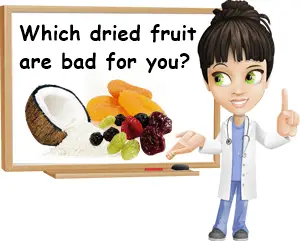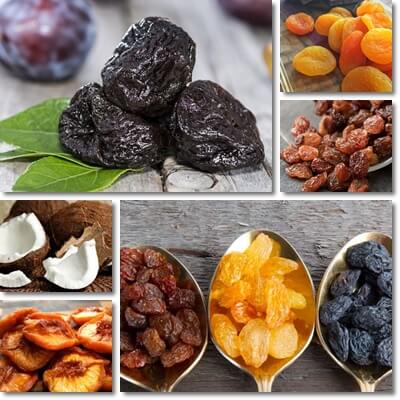Dried fruits are some of the healthiest food options available when they’re prepared right. However, addition of sugar, sweeteners, color enhancing agents and other additives can make even some of the healthiest dried fruit downright unhealthy. Ironically, the dried fruits that are most commonly consumed worldwide are often the least healthy ones because they are being made with various additives to increase shelf life. And while eating dried fruits containing various additives infrequently and in very small amounts will likely not produce any serious side effects, that doesn’t make it healthy either, or good for you for that matter. So what are the least healthy dried fruits to eat? Here is the list:
1) Dried plums, or prunes
Dried plums are both one of the healthiest dried fruits and one of the least healthy. Second only to raisins, they are ideal for relieving constipation naturally thanks to their excellent content of dietary fiber (7.1 g of dietary fiber/100 g of prunes). They are also a natural source of sorbitol, a sugar-alcohol with further laxative properties.

However, dried plums also often contain sulfur dioxide which is added to increase shelf life. Sulfur dioxide is a food additive known to cause headaches, migraines and allergic reactions in some people, with symptoms that range from hives, throat itching and swelling, sneezing to breathing difficulties and even trigger asthma episodes. Eating too many dried plums can also cause digestive upset and easily result in diarrhea so make sure your intake is moderate.
2) Raisins
Raisins represent the bulk of dried fruit production and are in high demand world wide. They can be made from essentially any grape variety and come in a wide range of colors, from golden brown and dark, red brown to green, purple and black. The advantage is that almost all raisins are naturally sun-dried which is a safe method of reducing moisture content in fruit. However, all raisin varieties and especially those beautiful, bright golden ones are treated with sulfur dioxide to increase their shelf life and enhance color.
In addition to a variety of minor side effects it can trigger in people sensitive to it, sulfur dioxide is especially bad for asthmatics and people suffering from chronic respiratory diseases in general. More serious side effects caused by eating raisins or other dried fruits containing sulfur dioxide include allergic reactions with anahylaxis and asthma attacks.
3) Dried coconut
Dried coconut can be prepared in the most natural way and result in a product of the purest quality, with wonderful benefits. At the same time, it can contain added sugar and even salt as well as chemicals such as sulfites, especially sodium metabisulfite (E223) for increased shelf life or propylene glycol as a sweetener. Sodium metabisulfite is a source of allergic reactions and can cause anaphylactic shock in those allergic to it. Propylene glycol is a synthetic compound used to make polyester products and can cause contact dermatitis and other symptoms of allergic reactions as well as trigger asthma episodes. Moreover, it is toxic if ingested in large amount.

4) Dried apricots
The number one problem with dried apricots is they contain sulfur dioxide for color enhancement. The bright, orange color of dried apricots is not natural and a direct result of a significant sulfur dioxide content. The compound is also responsible for the pleasant, chewy, soft texture of the dried fruit. In its absence, dried apricots would look brown instead of orange and have a rougher, less fine texture that would make them less palatable. At the same time, it is a source of allergic reactions and not healthy when consumed in large amounts.
5) Dried peaches
Like in the case of dried apricots, dried peaches are also loaded with sulfites to give them their beautiful, bright, orange color. Instead of the brightly-colored peaches and apricots, choose fruits that are brown-colored, but don’t contain this additive. These are the really healthy versions that are worth eating and will provide more benefits than the more colorful ones.
Of course, there are healthy and less healthy versions of the same dried fruit. Just like there are raisins, prunes and apricots full of sulfur dioxide, with added sugar or other sweeteners, there are versions of the same dried fruit that are healthy and natural. Naturally, there will be differences in appearance, sometimes taste and, most of all, price. Because the more natural a food product, the less additives it contains and the shorter its shelf life. So there is a chance it will be both less attractive and more expensive.
For example, apricots not containing sulfur dioxide will have a far less vibrant orange color or not even orange, but instead a less appealing brown color and will have a different, less chewy, less delicate and even rougher texture. Nonetheless, they will be healthier. Learn more about the nutritional properties, health benefits and side effects of your favorite dried fruits on the Nuts, Seeds and Dried Fruits page.
Conclusion
Essentially any dried fruit can be be made healthy or less healthy. This being said, it’s best to avoid dried fruits that are loaded with additives for enhancing color, taste and increasing shelf life, as well as all salted and sweetened products, even if it says on the label they’re sweetened with honey because it’s never the really healthy honey you should be eating. Look for dried fruits whose label doesn’t specify any additives or added sugars and other sweeteners, ideally from organic agriculture or, better yet, make your own dried fruit at home. It doesn’t get healthier and tastier than home-made.
